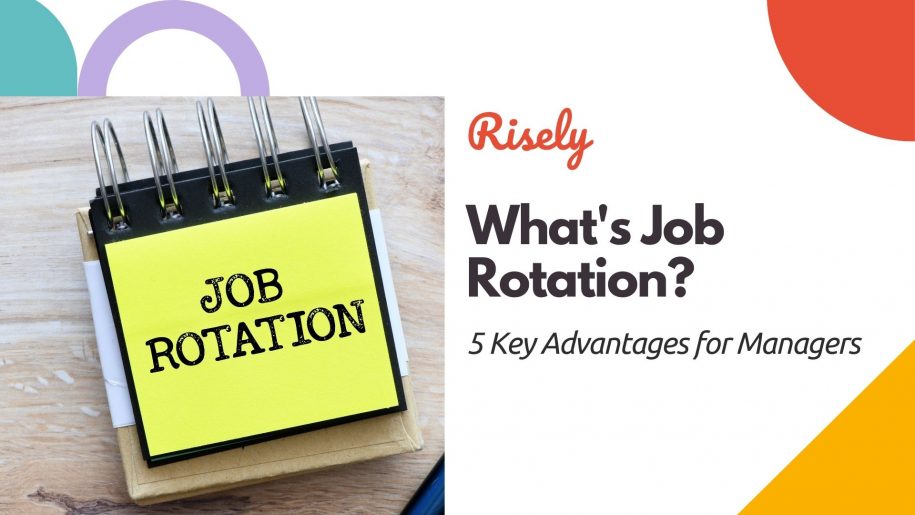What’s Job Rotation? 5 Key Advantages for Managers
Are you looking to enhance the skill set of your employees and improve their job satisfaction? Look no further than job rotation. It is a management strategy where employees are moved between different organizational roles and departments. In this blog, we will define job rotation, its purpose in management, advantages and disadvantages for both employers and employees, best practices for successful implementation, how to get started with job , and considerations when implementing it. By the end of this article, you will have a comprehensive understanding of job rotation’s benefits and be better equipped to implement it in your organization.What is job rotation?
Job rotation is when employees rotate through different organizational positions or roles. It can be done within a department or across various departments, and the goal is to provide employees with exposure to other areas of the business and help them develop a broader range of skills and knowledge. It can also help prevent burnout by providing employees with new challenges and opportunities for growth and increasing overall job satisfaction and engagement. Additionally, it can help organizations identify potential future leaders by allowing them to demonstrate their capabilities in various roles. Overall, this can be a valuable tool for employees and organizations.Purpose of job rotation in management
The purpose of job rotation is to allow employees to broaden their skills and knowledge by working in different roles or departments within an organization. It can help employees better understand the organization as a whole, develop new skills, and discover areas of interest that they may not have explored otherwise. It can also benefit the organization by increasing cross-functional collaboration, improving communication and teamwork, and promoting a more flexible and adaptable workforce. Additionally, it helps prevent burnout and improve employee engagement by providing new challenges and opportunities for growth.Examples of job rotation in use
- Cross-functional rotation: Team members are rotated across different organizational departments or functions. For example, a marketing specialist may spend some time working in the sales department or vice versa.
- Team rotation: Team members are rotated among teams or project groups within the same department. It allows them to gain exposure to different team dynamics, work on diverse projects, and develop a broader understanding of the department’s functions.
- Temporary assignment rotation: Team members are temporarily assigned to a different role or position for a specific period. It could involve filling in for a colleague on leave or participating in a special project or task force.
- Managerial rotation: Team members are allowed to rotate through various managerial roles within the organization. For instance, a manager from the marketing department might be rotated to oversee operations or human resources for a certain period.
- Geographic rotation: Team members are rotated across different locations or branches of the organization. It enables them to gain experience in different markets, cultural contexts, or operational environments.
Advantages and disadvantages of job rotation
Advantages of job rotation for employees
Rotation is one of the best ways to enhance an employee’s learning and development. These programs offer various departments where employees can explore their interests while learning new skills that will benefit them in the long run.- Skill development and broadening of knowledge
- Increased adaptability and flexibility
- Enhanced understanding of different functions and roles within the organization
- Opportunity to discover new interests and strengths
- Exposure to diverse work environments and challenges
- Development of a well-rounded skill set
Advantages of job rotation for employers
Employers who implement a rotation program reap numerous benefits. With job rotations, employers can efficiently identify their employees’ skill sets and competencies.- Enhanced workforce versatility and flexibility
- Improved cross-functional collaboration and communication
- Increased employee engagement and motivation
- Reduced employee turnover and retention of top talent
- Development of a more skilled and adaptable workforce
- Facilitation of knowledge sharing and transfer within the organization
Disadvantages of job rotation for employees
When employees begin a new role through job rotations programs like lateral movement or succession planning initiatives within their organization, it can cause them to feel uncertain or anxious about what’s ahead.- Potential for increased stress and adjustment challenges
- Disruption of established routines and familiarity with a specific role
- Difficulty in building deep expertise and specialization in a particular area
- Potential for decreased job security and stability during rotations
- Inconsistent performance evaluations and difficulty in tracking individual progress
- Potential for mismatched skills or interests in specific rotation assignments
Disadvantages of job rotation for employers
Employers must recognize that while job rotations has numerous benefits, it has potential drawbacks.- Temporary productivity decline during transition periods
- Potential disruption of team dynamics and collaboration during rotations
- Cost and time associated with training and onboarding employees in new roles
- Risk of knowledge loss when employees move to different positions or departments
- Challenges in maintaining continuity and consistent workflow during rotations
- Potential for resistance or reluctance from employees to adapt to new roles
Job rotation best practices for successful implementation
Successful implementation of rotation programs requires adherence to several best practices.Estimating the suitable duration for job rotation
To ensure job rotations success, estimating the suitable duration is essential. The idea is to balance providing new skills and avoiding disruption. Experts suggest rotating employees every six months to a year, depending on the nature of their roles and performance. A shorter duration may work better for highly specialized roles or jobs with limited growth opportunities. In contrast, longer durations can aid in developing leadership skills and preparing employees for management positions. Keeping such factors in mind while designing a rotation program can help organizations achieve their talent development and retention goals.Listening to employee feedback for a successful job rotation program
Listening to employee feedback is one of the most critical factors in its success. This approach will ensure that your rotational plan caters to the requirements of both your employees and your organization. By involving them in the program, you automatically increase engagement and motivation levels, resulting in better retention and enhanced performance by your employees. Scheduling regular check-ins with your workforce will help address any issues or concerns while making necessary changes.How to get started with job rotation?
To effectively implement job rotation:- Start by identifying suitable job roles and clearly defining the goals for each course. Involving employees in the planning process can increase engagement while communicating the benefits of job rotation encourages buy-in. –
- Providing necessary training equips employees with the skills they need to succeed in new responsibilities. –
- Regularly evaluating the effectiveness of your job rotation program helps you make adjustments as needed.
- With these steps successfully integrated into your company culture, you can use job rotation for employee development and career advancement.
Considerations when implementing job rotation
Setting clear goals and objectives is essential for a successful program, setting clear goals and objectives is important. When deciding on the duration of each rotation, consider factors such as employee burnout and boredom. Matching employees with suitable roles based on their skills and interests is also crucial. Effective communication is essential for a smooth implementation process. Remember that job rotation offers many benefits for employers and employees but can be challenging too.Addressing time-consuming challenges
When implementing a job rotation program, addressing potential time-consuming challenges is essential. To avoid burnout and other adverse effects of job rotation, companies should set clear goals for the program and define roles and responsibilities for each employee involved. Consistent communication with employees can also ensure everyone is on the same page throughout the process.Ensuring Employee Gets Time to Learn
Providing adequate training and support is one effective way to ensure that employees transition smoothly and develop new skills during a rotation. It helps them to adjust to their new roles comfortably and increases their overall job satisfaction and motivation. Effective communication with employees throughout the process can make all the difference in ensuring a successful job rotation program.Ensuring employee success with job rotation
Providing adequate training and support to employees in their new roles is essential. Effective communication is critical for implementation, ensuring that employees understand the purpose and benefits of the program and helping them adjust to different tasks or departments without losing productivity. It also helps identify areas where additional training or development may be required for better performance. Regular check-ins and feedback sessions can help increase employee engagement and satisfaction while improving competencies, career path clarity, retention rates, and company culture.Conclusion
To sum up, job rotation is an effective tool for managers to increase employee engagement, reduce boredom, and enhance their skills. It also helps organizations build a robust succession planning program and retain key talent. To ensure a successful implementation of job rotation, it’s essential to create a solid plan that considers the duration of each rotation and gathers feedback from employees to refine the process continually.Test your communication skills now to become an effective collaborator with teams
Get detailed insights delivered straight to your inbox in just a few minutes.
Other Related Blogs
How to Set Effective Learning and Development Goals?
This blog highlights how effective learning and development goals are set, why is setting them important for your organization and what challenges you might face during this process. … Read…
Are you on track to meet your Q1 goals?
Are you on track to meet your Q1 goals? We are in the middle of the first quarter of 2024. Seems hard to believe. It surely is! ⏰ Time has…
5 Secrets Of Solid Goal Setting At Work You Can’t Miss
5 Secrets Of Solid Goal Setting At Work You Can’t Miss “I don’t focus on what I’m up against. I focus on my goals and I try to ignore the…
Understanding the world of Goal Setting Coach to reach new heights
Understanding the world of Goal Setting Coach to reach new heights Setting and achieving goals is essential for personal and organizational success in today’s fast-paced and competitive work environment. However,…


